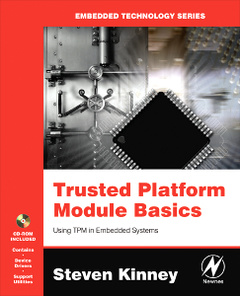Description
Trusted Platform Module Basics
Using TPM in Embedded Systems
Embedded Technology Series
Author: Kinney Steven L.
Language: English
Subjects for Trusted Platform Module Basics:
Publication date: 09-2006
368 p. · 19x23.3 cm · Paperback
368 p. · 19x23.3 cm · Paperback
Description
/li>Contents
/li>Readership
/li>Comment
/li>
- Clear, practical tutorial style text with real-world applications
- First book on TPM for embedded designers
- Provides a sound foundation on the TPM, helping designers take advantage of hardware security based on sound TCG standards
- Covers all the TPM basics, discussing in detail the TPM Key Hierarchy and the Trusted Platform Module specification
- Presents a methodology to enable designers and developers to successfully integrate the TPM into an embedded design and verify the TPM's operation on a specific platform
Chapter 1: History of the Trusted Computing Group Chapter 2: Cryptographic BasicsChapter 3: Software vs. Hardware Based Security Models Chapter 4: Hardware Design ConsiderationsChapter 5: TPM Architectural OverviewChapter 6: Root of Trust, the TPM Endorsement KeyChapter 7: Key Hierarchy and ManagementChapter 8: Platform Configuration RegistersChapter 9: TPM Command Message OverviewChapter 10: TPM Intra Message StructuresChapter 11: Anti-Replay Protection and Rolling Nonces Chapter 12: Command AuthorizationChapter 13: Communicating with the TPM, Intel’s Low Pin Count (LPC) BusChapter 14: TPM LPC Base Address Definitions and FunctionalityChapter 15: TPM Sacred Seven Command SuiteChapter 16: Compliance Vectors and Their PurposeChapter 17: TPM System Deployment Initialization Chapter 18: Establishing a TPM Owner and Owner Authorized Command SuiteChapter 19: TPM Cryptographic Command Suite Chapter 20: TPM PCR Command Suite Chapter 21: TPM Protection Profile Chapter 22: Trusted Device Driver Chapter 23: Trusted Device Driver Layer and Interface Chapter 24: Sequential Command Examples Chapter 25: Migrating to the 1.2 Version of the TPMAPPENDIX A: TPM Command List by OrdinalAPPENDIX B: TPM Error List by Return Code APPENDIX C: SMBus, An Alternate Communication ModelAPPENDIX D: Compliance Test Suite Source Code, C Source
PRIMARY MARKET: industry training/self-education of embedded developers, computer engineers, software engineers, hardware engineers
SECONDARY MARKET: Graduate-level embedded systems/computer engineering
students at colleges and universities
SECONDARY MARKET: Graduate-level embedded systems/computer engineering
students at colleges and universities
- This sound foundation on the TPM provides clear, practical tutorials with detailed real-world application examples
- The author is reknowned for training embedded systems developers to successfully implement the TPM worldwide
© 2024 LAVOISIER S.A.S.

